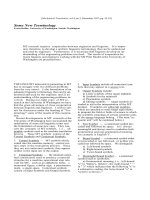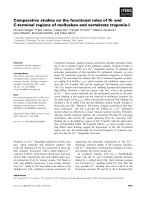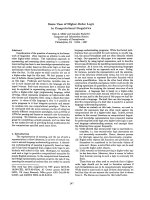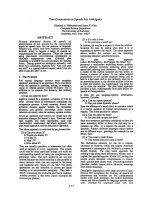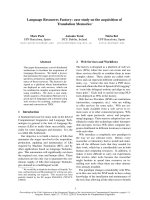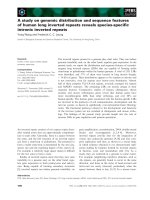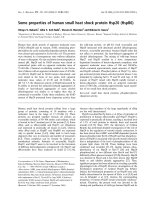Báo cáo khoa học: "SOME REASON ON CASE RELATIONS" potx
Bạn đang xem bản rút gọn của tài liệu. Xem và tải ngay bản đầy đủ của tài liệu tại đây (313.29 KB, 4 trang )
SOME RE~h~RXS ON CASE RELATIONS
JGrgen Kunze
Zentrallnstltut fGr Sprachwissenschaft
Akademle der Wissensch~ften der DDR
Prenzlauer Promenade 149-152
Berlin
DDR-1100
ABSTRACT
The topic of the paper is the problem
how to define case relations by semantic
predicates. A general principle is out-
lined, which renders it possible to
"calculate" case relations for a given
representation of a (verb-)sememe by
means of expressions. This principle is
based on an assignment of case relations
to primitive predicates and modification
rules for nested expressions. Contrary
to the traditional case grammar it turns
out ~ha~ one needs mixed case relations,
especially for two reasons: Arguments
occur at "too different" places in an
expression or arguments ~iave combined
case relations. The consequence is that
case relations don't form a set of iso-
lated elements but a structured system.
I. Introduction
The paper is not intended for defending
case relations in general. I want to
s~e~ch only some problems connected with
the definition of case relations ~ud will
demonstrate consequences, which seem
partly a oit "unconventional".
I will not enter into the terminolo-
gical discussion on deep cases, case
relations etc. and subsume all these
variants under the label "case relation".
This is justified by the obvious fact
that there are more proposals and systems
than authors. So one will not overcome
this chaos by neat terminological distinc-
tions. It is rather typical for publica-
tions on deep cases that proposals are
presented without sufficient motivation
or justification (e. g. Nilsen 1973).
It has turned out tha~ in the matter
of case relations as a field of linguis-
tic and fundamental research intuition
and language competence cannot show the
right way how to solve the problems of
defining them. This is my first conclu-
sion from the general scene. Without
doubt it is inevitable to work out some
principles on the basis of which case
relations may be defined. This would
enable us
- to discuss a rather "clear" object
(some principles instead of tens (or
hundreds) of proposals),
- to evaluate and compare existing pro-
posals,
- to connect case relations with other
essential notions.
Quite another question is "What are case
relations good for?". One cannot ignore
the fact that a lot of serious objections
against case relations have been advanced,
covering a whole range from "they are
redundant" till "the swamp of lacking
plausible (or even formal) definitions"
resulting in the conclusion that case
relations are useless especially for
computational linguistics (Mellema 1974,
Luckhardt 1985). On the other hand many
authors are advocates pro case relations,
even in MT (e. g. Nagao 1986, Somers
1986). Here the character of case rela-
tions as a link (or pivot) is stressed -
between surface and deep level or between
nguages. For sucA situations one can
cept the use of case relations without
exact definitions having an experimental
system as a touchstone.
Case rela~ion~ are considered here as
names or labels of arguments in semantic
~
redicates used for the description of
verb-)sememes. This is only one side of
the coin! The second important aspect are
the means by which deep cases are ex-
pressed at the surface (grammatical cases,
prepositions, linear order, ). They
have to be taken into account as well,
and only both aspects together will yield
an adequate picture.
2. Case relations and semantic predicates
One possibility to grasp the whole
problem seems to be the definition of
case relations on the basis of semantic
predicates. Sememes (of vero-lexemes) are
represented by expressions containing
primitive semantic predicates. The fol-
lowing expression may be assigned to a
verb like "to convey": (a conveys b from
c to d)
(1) MOVE-ACTION(a,b,c,d)
=ACAUSE(a,CHANGE-POSITION(b,c,d))
(cf. Allen 1984). I will not discuss the
question whether ACAUSE (= "agent caus-
ation") and CH~GE-POSITTON are indeed
302
primitive predicates. I consider them
here as that. Furthermore one may discuss
whether (5) sufficiently describes the
meaning of "to convey".
The idea of extracting case relations
from representations lige (1) can be
bases on the following principles:
(A) For each primitlve predicate P there
is an assignment of exactly one case
relation to every argument place~:
zi(P) = r~ (i-th argument of P h~s
case relation ri)
(B) There are modification rules for case
relations which render it possible to
"calculate" the case relations for
nested expressions.
(A) means e. g. that for a primitive pre-
dicate like CHANGE-POSITION w know the
case relations of the argument places b,
c and d:
(2) zi(C~JdIGE-POSITION ) = r i for 1 ~ i ~ 3
In this sense one can state without doubt
(3) Zl(ACAUSE) = agent
(~) z3(CHANGE-POSTTION) = goal
(B) may be interpreted in the following
way: If we know
- MOVE-ACtION has the form given in (1),
- the value of z2(ACAUSE),
- second place of ACAUSE is filled in by
CHA2~E-POSITION,
- the value of Zl(CHANGE-POSITION),
then we know
-
the value of z2(EOVE-ACTION ), i. e. the
case relation of b in the whole expres-
sion (1).
Formally this may be expressed by a
four-place "modification mapping" m:
(5) zg(MOVE-ACTION) =
m~ACAUSE, z2(ACAUSE), CHANGE-POSIT!ON,
z I (CHANGE-POSITION) )
One may speculate whether all four argu-
ments are indeed necessary, they are
surely no~. A similar idea is presented
in Thiel 1982 (p. 84 ff.), where the
mechanism of modification is applied,
tOO.
A general scheme for (B) is the
following: Assume one has
(6)
,
s( ,x, ), )
where x is the j-th argument in Q,
S( ) the k-th argument in R and x the
1-th argument in S. Then zg(Q) is a
function of R, Zk(R), S an~ Zl(S ). Thiel's
proposal, namely zj(Q) = m(R, Zl(S)),
would cause some dlfficulties, if R is a
many place predicate and there are in R
arguments S' and S" with z I, (S')=Zl,, (S")
(cf. the FEED-example below). Thiel him-
self excludes this case explicitely.
The principles (A) and (B) form a re-
cursive scheme: (A) provides the results
for certain predicates, (B) renders it
~
ossible to determine the results for
verb-)sememes in general.
At arj rage one would get a nice for-
malism for calculating case frames if (A)
and (B) are fulfilled. Unfortunately,
there are some additional problems I will
deal with below. But at first T take an
example :
(7) SET(a, b, c)
= ACAUSE( a, BECOI~[E ( SIT( b, c) ) )
(8) z2(SIT)= locative
By a simplification of the general
scheme (four-place function m as in (5))
to the special variant one would obtain
for (7-8):
(9) z~(S~.T)
= ~m(A CAUSE, m( BECO},~, 1 o cati re) )
= m(ACAUSE,dlrective) = directive
There are arguments for the assumotion
that BECOI~ (and not ACAUSE) modifies
locative to dieective (or goal): The
description of "to get to a place"
contains the expression
(10) BEC01~(BE(b,c)) (as in (7))
Here one has the s~ae modification of
locative to directive. This is in ac-
cordance with Thiel 1982.
Instead of (7) one coulc take another
expression, e. g. by using the predicate
ECAUSE (event causation) with the inter-
pretation that "an activity of a causes
BECO~ (S! T( b, c ) )" :
(lq) SE~(a,b,c)
= ECAUSE(ACT(a), BECOICE(SIT(b, c)))
Here the application of (A) and (B) is
not quite the same, one has here instead
of
(12) Zl(SET ) = Zl(ACAUSE ) for (7)
a modification
(13) zI(SET) = m(ECAUSE, z~(ACT))
m(ECAUSE, a~entiv)
= "causator" ?
These simple examples illustrate some
connections between the formal defini-
tion of case relatior.s and semantic
predicates.
3. Ex~pected complications
Now ! turn so some :~upleasant ques-
tions that depress a bit the hope in
this elega~ut solution. But they are
disagreeable only if one
303
-
maintains the principle "one instance
~
er simple clause" for case relations
cf. Fillmore 1968, Starosta 1981) and
-
considers case relations as a rather
small set without internal structure.
For a verb li~e "to swim" in a sentence"
like "a swims from b to c" it is reasona-
ble to assume a representation
(1@) SWIM(a) g CHANGE-POSITION(a,b,c)
What wo ao if in this example (or another
of the same type) one detects that
(15) Zl(SWIM) @ Zl(CHANGE-POSITION)?
Secondly, one needs new rules for h~dling
an example like
(16) ASCERTAIN(a,b)
= ACAUSE(a,BECO~(KNOW(a,b)))
where a appears twice and at two rather
different places. One surely cannot assume
that Zl(ACAUSE) is the same relation as
(17) m( ACAUSE, m( BEC0~{E, z I (~NOW) ) )
if one makes the same simplification am
for (7). Another question appears in
(18) FEED( a, b, c) = ACAUSE( a, EAT( b, c) )
This time one has two agents (a and b).
The next question is due to reflexive
verbs. If we ta~e German examples, we
have e. g.
(19) Er w~scht sich $ Er w~scat ihn
as in English, too (himself ¢ him). Here
the case relation of "Er" should be a
mixture between agent ~n~something like
experiencer or patiens (cf. Thiel 1982,
p. 10@ f.). The second components may
not be left out because of the reflexive
verbs proper in German as "sich ft[rchten"
(to be afraid, "sich sch~me~' (~o be
ashamed). Here the appropriate case rela-
tion is not agent: A "semantic paraphrase"
for these verbs is "Etwas macht mich
f~rchten" (Something makes me afraid)
etc. In my opinion there is no sharp
boundary oetween the two types of re-
flexive verbs: Such a critical case is
e. g. "sich aufregen" (to ge~ excited).
The fifth question is connected with
"plastered up" case relations. It does
not make sense to discuss whether one has
in (20) either the case relation instru-
mental or locative (cf. Thiel 1982,
p.
10@
f.):
(20) I warmed ~he foot on the stove.
The same applies for temporal and causal
relations in other examples.
@. Some conclusions
From the questions and lacking answers
one may draw some conclusions:
!. If one defines case relations by
means of semantic predicates as ex-
plained above, one needs in addition at
least one of these two things:
-
a two-place relation " ~ " within the
set of case relations in order to com-
pare them according to their "specl-
ficness": For certain pairs of case
relations rl,r 2 one has then "r I ~ rp"
with the meaning "r I is equal to or -
more specific than ro" (cf. the SWIM
example). In this sense one may say
that e. g. objective is "the semantical
most neutral case" (Cook 1971), i. e.
one could establish case relations that
are more specific than the case rela-
tion objective.
- a two-place operation " @ " for mixing
case relations: For certain pairs of
case relations r~,r 2 there is a case
relation r with ~ = r I • r 2 (cf. the
example (20)).
So the set of all case relations becomes
a structured system: Every case relation
stands no longer for itself alone.
II. One cannot derive case relations from
semantic predicates without presupposing
a synonymy relation between sememes: If
one assumes that uhe twJo sentences
(21) John sells Jim a car.
(22) Jim buys a car from John.
are synonymous, i. e.
(23) SELL(a,b,c) and
(24) BUY(b,a,c)
have the same representation, then the
case relations have to be tae same:
(25) Zl(S~) = z2(BUY) (of a)
z2(SELL) Zl(BUY) (of b)
If one admits that (21) and (22) are not
synonymous one ma~, have different case
relations.
This aspect is in a sense inde-
pendent of the approach proposed here:
The same question may be put without
reference to semantic predicates. One
needs such a synonymy relation at any
rate for case relations. Obviously the
different intuitive use of the synonymy
is one reason for the rather chaotic
situation.
I!T. A aiscussion of (23-2@) and (18)
shows furthermore that a relation or
operation mentioned in T. provides the
means for a distinction of different
agents as John and Jim in (21-22) or
the two agents in (18): Tn the latter
case b is an "influenced agent". This
has to be expressed precisely by the
modification rules.
304
References
Allen, J. F. 198@ Towards a General
Theory of Action and Time. In:
Artificial Intelligence 23: 123-154.
Cook, W. A. 1971 Improvements in Case
Grammar. In: Language and Linguists,
Working Paper Nr. 2, Georgetown
University, Washing$on D. C.
Fillmore, Ch. 1968 The case for case.
In: Bach, E., Harms, R. T., Eds.,
Universals in Linguistin Theory,
Holt, Rinehart and Winston, New
York: 1-88.
Fillmore, Ch. 1977 The case for case
reopened. In: Cole, P., Sadoc~, J. M.,
Eds., Syntax and Semantics 8:
Grammatical Relations, Academic
Press, New York: 59-82.
Koch, W. 1978 Kasus - Kognition - Kausa-
liter. Lunder germanistiscae For-
schungen 47, C~ Gleerup, Lurid.
Luckhardt, H D. 1985 Valenz und Tiefen-
~asus in der maschinellen $0erset-
zung. CL-Report No @, Sonderfor-
scaungsbereich 100, Teilprojekt A2,
Universit~t des Saarlandes, Saar-
brGc~en.
~ellema, P. 197@ A Brief Against Case
Grammar. In: Foundations of Language
11 : 39-76.
Nagao, M. 1986 Current Status and Future
Trends in Hachine Translation. In:
Future Generations Computer Systems
2(1986): 77-82.
Nilsen, D. L. F. 1973 The Instrumental
Case in English. Mouton, The Hague.
Somers, H. L. 1986 The need for MT-ori-
ented versions of Case and Valency
in MT. In: Proceedings COLING-86:
118-123.
Starosta, St. 1981 Die "l-Pro-Sent"-LS-
sung. In: Pleines, J. Ed., Bei~r~ge
zum Stand der Kasus~heorie, Gunter
Narr, TGbingen: 45-1@7.
Thiel, M. 1982 Zur Verwendung der Kasus-
gramzatik im faktenorientierten
Information Retrieval yon Textdaten.
Spracae und Information, vol. 2,
Niemeyer, TGbingen.
Address of the author:
Prof. Dr. Jttrgen Kunze
Z~ ft~r Sprachwissenschaft der AdW der DDR
Prenzlauer Promenade I@9-152
Berlin
DDR-qlO0
305
